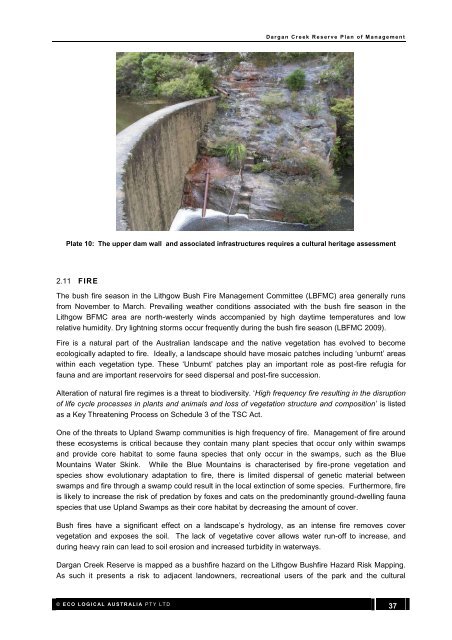Draft Plan of Management for the Dargan Creek Reserve - Land
Draft Plan of Management for the Dargan Creek Reserve - Land
Draft Plan of Management for the Dargan Creek Reserve - Land
Create successful ePaper yourself
Turn your PDF publications into a flip-book with our unique Google optimized e-Paper software.
D a r g a n C r e e k R e s e r v e P l a n o f M a n a g e m e n t<br />
Plate 10: The upper dam wall and associated infrastructures requires a cultural heritage assessment<br />
2.11 FIRE<br />
The bush fire season in <strong>the</strong> Lithgow Bush Fire <strong>Management</strong> Committee (LBFMC) area generally runs<br />
from November to March. Prevailing wea<strong>the</strong>r conditions associated with <strong>the</strong> bush fire season in <strong>the</strong><br />
Lithgow BFMC area are north-westerly winds accompanied by high daytime temperatures and low<br />
relative humidity. Dry lightning storms occur frequently during <strong>the</strong> bush fire season (LBFMC 2009).<br />
Fire is a natural part <strong>of</strong> <strong>the</strong> Australian landscape and <strong>the</strong> native vegetation has evolved to become<br />
ecologically adapted to fire. Ideally, a landscape should have mosaic patches including „unburnt‟ areas<br />
within each vegetation type. These „Unburnt‟ patches play an important role as post-fire refugia <strong>for</strong><br />
fauna and are important reservoirs <strong>for</strong> seed dispersal and post-fire succession.<br />
Alteration <strong>of</strong> natural fire regimes is a threat to biodiversity. „High frequency fire resulting in <strong>the</strong> disruption<br />
<strong>of</strong> life cycle processes in plants and animals and loss <strong>of</strong> vegetation structure and composition‟ is listed<br />
as a Key Threatening Process on Schedule 3 <strong>of</strong> <strong>the</strong> TSC Act.<br />
One <strong>of</strong> <strong>the</strong> threats to Upland Swamp communities is high frequency <strong>of</strong> fire. <strong>Management</strong> <strong>of</strong> fire around<br />
<strong>the</strong>se ecosystems is critical because <strong>the</strong>y contain many plant species that occur only within swamps<br />
and provide core habitat to some fauna species that only occur in <strong>the</strong> swamps, such as <strong>the</strong> Blue<br />
Mountains Water Skink. While <strong>the</strong> Blue Mountains is characterised by fire-prone vegetation and<br />
species show evolutionary adaptation to fire, <strong>the</strong>re is limited dispersal <strong>of</strong> genetic material between<br />
swamps and fire through a swamp could result in <strong>the</strong> local extinction <strong>of</strong> some species. Fur<strong>the</strong>rmore, fire<br />
is likely to increase <strong>the</strong> risk <strong>of</strong> predation by foxes and cats on <strong>the</strong> predominantly ground-dwelling fauna<br />
species that use Upland Swamps as <strong>the</strong>ir core habitat by decreasing <strong>the</strong> amount <strong>of</strong> cover.<br />
Bush fires have a significant effect on a landscape‟s hydrology, as an intense fire removes cover<br />
vegetation and exposes <strong>the</strong> soil. The lack <strong>of</strong> vegetative cover allows water run-<strong>of</strong>f to increase, and<br />
during heavy rain can lead to soil erosion and increased turbidity in waterways.<br />
<strong>Dargan</strong> <strong>Creek</strong> <strong>Reserve</strong> is mapped as a bushfire hazard on <strong>the</strong> Lithgow Bushfire Hazard Risk Mapping.<br />
As such it presents a risk to adjacent landowners, recreational users <strong>of</strong> <strong>the</strong> park and <strong>the</strong> cultural<br />
© E C O L O G I C A L A U S T R A L I A P T Y L T D<br />
37

















